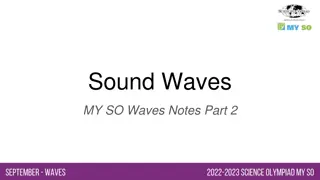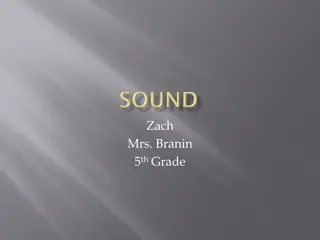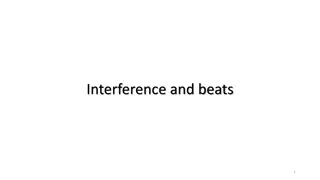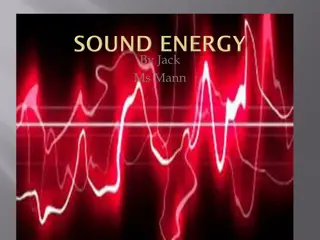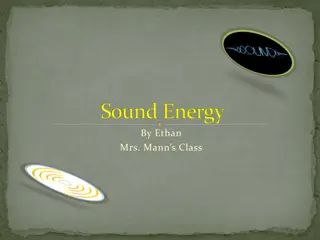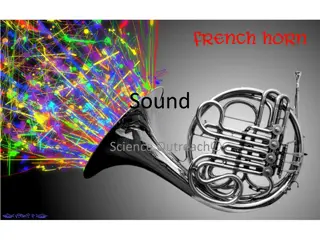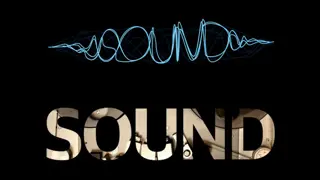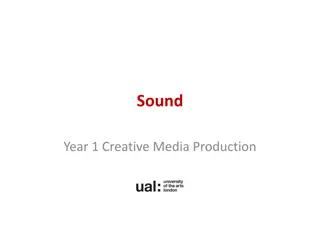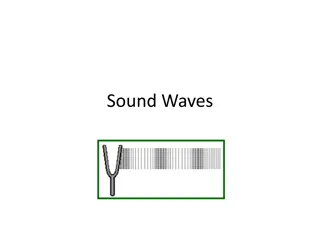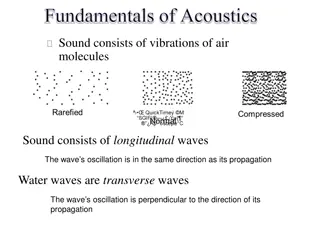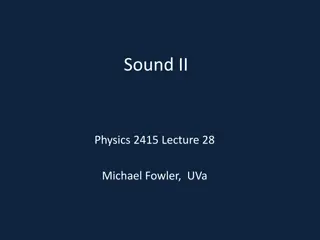Exploring the Nature of Waves and Sound
Understanding the nature of waves, both transverse and longitudinal, and their properties such as amplitude, wavelength, and frequency. Delve into the world of water waves, periodic waves, and the speed of waves on a string. Learn about the longitudinal nature of sound waves, the audible frequency range, and the objective and subjective properties of sound. Discover how we hear and the fascinating uses of infrasonic and ultrasonic waves.
Download Presentation

Please find below an Image/Link to download the presentation.
The content on the website is provided AS IS for your information and personal use only. It may not be sold, licensed, or shared on other websites without obtaining consent from the author. Download presentation by click this link. If you encounter any issues during the download, it is possible that the publisher has removed the file from their server.
E N D
Presentation Transcript
The Nature of Waves Wave is a traveling disturbance. Wave carries energy from place to place. There are two basic types of waves: Transverse waves Longitudinal Waves The disturbance is perpendicular to the direction of travel of the wave. The disturbance is parallel to the direction of travel of the wave. Example: Sound wave in air. Examples: Light wave, waves on a guitar string.
Water Waves Water waves are partly transverse and longitudinal. Dominoe Topling: Human wave at a sport stadium:
Periodic Waves: waves that repeat The amplitude, A is the maximum disturbance. The wavelength, is the horizontal length of one cycle of the wave. The period, T is the time required for one complete up/down cycle of the wave. The frequency, f is the number of waves per unit time, f=1/T. Wave Speed =
The Speed of a Wave on a String T T = Tension provided by the hanging mass ? = v = ???? ????? , of the string.
The Nature of Sound Longitudinal Sound Waves Sound in air is a longitudinal wave that is created by a vibrating object, such as a guitar string, the human vocal cords, or the diaphragm of a loudspeaker. Sound cannot propagate in a vacuum. Bell in a vacuum
The Frequency of a Sound Wave Audible Range: 20 Hz ----- 20,000 Hz. Infrasonic waves: Sound waves with frequencies < 20 Hz. Rhinoceroses use infrasonic frequencies as low as 5 Hz to call one another Ultrasonic waves: Sound waves with frequencies > 20,000 Hz. Bats use ultrasonic frequencies up to 100 kHz for locating their food sources and navigating.
Objective and Subjective properties of sound Objective properties can be measured, used in physics. Subjective properties are subjective to the person, used in music. Objective property Subjective quality Frequency Pitch Intensity Loudness Waveform Tymbre or Quality
Speed of Sound in an ideal gas = 1.40 (ratio of specific heats for air) m = 4.8 x 10-26 kg (average molecular mass of air) k = 1.38 x 10-23 J/K (Boltzmann constant) T= temperature in Kelvin kT = v m Gases Speed of Sound (m/s) Liquids Speed of Sound (m/s) Solids Speed of Sound (m/s) Air (0 C) 331 Chloroform (20 C) 1004 Copper 5010 Air (20 C) 343 Ethyl alcohol (20 C) 1162 Glass (Pyrex) 5640 Carbon dioxide (0 C) 259 Mercury (20 C) 1450 Lead 1960 Oxygen (0 C) 316 Fresh water (20 C) 1482 Steel 5960 Helium (0 C) 965 Seawater (20 C) 1522 Inhaling Helium and Sulfur Hexafluoride
Sound Intensity The sound intensity I is defined as the sound power P that passes perpendicularly through a surface divided by the area A of that surface: The unit of sound intensity is power per unit area, or W/m2.
Decibels The decibel (dB) is a measurement unit used when comparing two sound intensities. The intensity level (expressed in decibels) relative to the threshold of hearing, Io is defined as follows:
Typical Sound Intensities and Intensity Levels Relative to the Threshold of Hearing Intensity Level (dB) Intensity I (W/m2) Threshold of hearing 1.0 10-12 0 Rustling leaves 1.0 10-11 10 Whisper 1.0 10-10 20 Normal conversation (1 meter) 3.2 10-6 65 Inside car in city traffic 1.0 10-4 80 Car without muffler 1.0 10-2 100 Live rock concert 1.0 120 Threshold of pain 10 130
Longitudinal Standing Waves Musical instruments in the wind family depend on longitudinal standing waves in producing sound. Since wind instruments (trumpet, flute, clarinet, pipe organ, etc.) are modified tubes or columns of air, it is useful to examine the standing waves that can be set up in such tubes.
Open tube of air A pictorial representation of longitudinal standing waves on a Slinky (left side) and in a tube of air (right side) that is open at both ends (A, antinode; N, node).
Closed tube of air A pictorial representation of the longitudinal standing waves on a Slinky (left side) and in a tube of air (right side) that is open only at one end (A, antinode; N, node).






